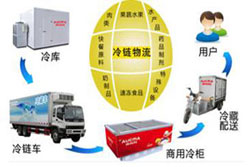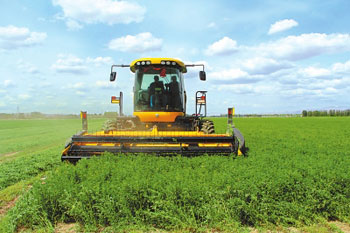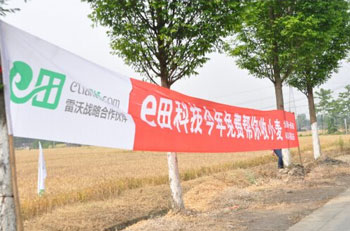Cold chain logistics reduces the cost of fresh cross-province non-normal temperature
Original title: cold chain has high cost and few facilities, and the development of fresh e-commerce has encountered logistics bottleneck.
Keep fresh only with cold chain (focus on supply-side reform)

Cold chain logistics (network diagram)
Cost reduction is one of the important tasks of supply-side structural reform. The Central Economic work Conference held at the end of last year called for helping enterprises reduce costs. It is clearly put forward that "it is necessary to reduce logistics costs and promote the reform of the circulation system." The lack of cold chain facilities and high cost is one of the shortcomings of China's logistics system, which restricts the healthy development of fresh e-commerce and other industries. At present, there is an urgent need for China to reduce the cost of cold chain logistics by improving relevant supporting facilities and policies.
Chen Jianfeng was pleasantly surprised to find that Haagen-Dazs ice cream could be bought on Shun Feng's website as a Mother's Day gift for his mother in Ji'an, Jiangxi Province. Just a few years ago, in a small city like Jian, it was an extravagant hope to buy ice cream online, and the imported fruit on many shopping websites could not be delivered there.
I do not know since when, the express electric car in addition to large and small cartons, sometimes there will be an extra car mini refrigerator. Imported yogurt, Dutch tulips, Argentine frozen red shrimp. Cold chain express from scratch, once again narrowed the distance between people and the world.
The cold chain distribution resources are not enough, and most of the fresh food is transported at room temperature across provinces.
Cold chain express is obviously not as developed as ordinary express. Mr. Wang from Beijing once went to Guangdong on a business trip and wanted to send a box of Maoming lychees to his family. He asked several express delivery companies before he found one that could be delivered through the cold chain. As a result, when the family received it, some of the lychees were broken. "the litchi was wrapped in a styrofoam box with two small ice packs, which had melted by the time they were received." Mr. Wang said, "if there happens to be no one at home and the courier takes the litchi all morning, isn't it all broken?"
"this is precisely a difficult problem that cold chain express is facing." The person in charge of Shun Feng cold transportation said that the most obvious difference between express delivery and logistics is that logistics is from Hong Kong to Hong Kong, station to station, while express delivery is door to door. One of the characteristics of cold chain express is scattered orders, which means that the delivery process will open the door frequently, and it is more difficult to control the temperature of the refrigerated space. Moreover, cold chain express has higher requirements for timeliness, and the problems often encountered in express delivery, such as electric tricycles being seized and not allowed to enter the community, have a greater impact on cold chain express delivery, including the situation that Mr. Wang mentioned that there is no one at home. Will greatly increase the cost of distribution.
"not to mention cold chain express delivery, even the development level of cold chain logistics can not meet the market demand. The poor distribution of cold chain has become a bottleneck restricting the development of fresh e-commerce. " Chen Tao, logistics director of Cainiao Network Technology Co., Ltd., said.
Cainiao Network is Alibaba's express logistics coordination platform, helping e-commerce coordinate distribution resources is one of Chen Tao's daily work. "our biggest feeling when coordinating cold chain resources is that there are not enough resources." Chen Tao said, "most of the fruits of origin that we eat in our daily life, such as grapes and Guangdong litchi, are actually transported at room temperature by road, refrigerated in storage after arriving at the place of sale, and delivered when customers place orders. As a result, the damage is relatively high, and the taste will be affected. "
The cost of cold chain distribution is high, the total amount of enterprises is insufficient and the service quality is mixed.
From the transportation of grapes to Beijing, the loss of road transportation at room temperature may be more than 1x3. Why do merchants still choose room temperature transportation instead of cold chain transportation? The most direct reason is the high cost of cold chain.
"under the same turnover rate, the cold chain distribution investment is at least twice as high as that of ordinary express delivery." The person in charge of Shunfeng cold transportation calculated an account for the reporter: in terms of vehicles, cold chain transport uses refrigerated vehicles, the state has restrictions on the appearance size of trucks driving on highways, and refrigerated vehicles must be installed with insulation, so the storage capacity is smaller than ordinary trucks. Refrigeration equipment also consumes energy, so the operating cost is much higher; in terms of warehousing, cold chain express logistics needs to use three-temperature warehouses, and the cost is also higher than that of room temperature warehouses. In terms of transfer and distribution operation, cold chain express needs constant temperature operation room and special work clothes, which not only has a large investment in the early stage, but also consumes a lot of energy during operation; in terms of end distribution, cold chain express needs special utensils and appropriate refrigerant solutions, which is also much more expensive than ordinary express cartons and schoolbags....
For fresh e-commerce companies that directly face consumers, the volume of each order is often small and the cost cannot be diluted by increasing the scale, so the cost of cold chain express delivery is even higher.
Another reason why businesses are unwilling to choose cold chain transportation is that the total amount of cold chain express logistics enterprises is insufficient and the service quality is mixed.
The actual situation in the current market is that the price of cold chain express delivery of food will not be too much higher than that of ordinary express delivery, for example, the price difference of distribution in the same city is less than double. Therefore, there are not many enterprises willing to develop cold chain express logistics.
Chen Tao said: on the one hand, China's cold chain infrastructure is generally inadequate. For example, refrigerated trucks account for only 0.3% of the total number of trucks in China, compared with 2% in Japan. On the other hand, the main body of cold chain distribution is small, and there are many enterprises scattered around the city that can do cold chain business in the same city, but there are few enterprises that can do cross-provincial cold chain distribution, and there is a lack of brand enterprises with high reputation.
Enterprises should take the road of specialization, and government departments need to clear the obstacles and set up a stage for enterprises.
The pain point of the market is the opportunity for development. E-commerce feels that cold chain distribution can not meet the demand, which precisely shows that there is a huge space for the development of cold chain distribution market. "promoting the development of cold chain distribution will effectively stimulate market demand." Shao Zhonglin, an expert at the National Post think tank, said, "just as the rapid development of the express delivery industry supports the continuous record-breaking of online retail, if the cold chain distribution can be developed, the development of fresh e-commerce will be more handy, which is bound to promote the upgrading of consumption." further activate the Internet economy. "
From the point of view of the enterprise, the development of cold chain distribution must first go through the cost.
The innovation of packaging materials and refrigerant technology can effectively reduce costs. For example, the EPP cycle incubator developed by Shunfeng is lighter and more resistant to pressure and falls, which reduces the cost of cold chain distribution; in the "last kilometer" distribution, Shunfeng switched to an independently developed ultra-low temperature cold storage agent instead of dry ice to distribute ice cream, which not only reduced the cost, but also prolonged the cold preservation time.
Information means such as big data can also reduce costs. The cost of cold chain delivery of fresh food in China is high, one of the objective reasons is that the transportation is mostly one-way, so the main line refrigerated vehicles often have empty return. Cainiao network through the communication of e-commerce and delivery enterprise information, on the one hand, fresh product logistics orders into a whole, diluting the cost; on the other hand, do not turn on air-conditioning, normal temperature transport of daily consumer goods, improving the efficiency of refrigerated vehicles. In addition, the application of big data technology can also help cold chain distribution enterprises to find both fresh-keeping and energy-saving distribution temperature, but also can play a role in reducing costs.
However, the investment of cold chain distribution will certainly be greater than that of ordinary express delivery. Therefore, taking the professional road is a more realistic choice for the development of cold chain distribution. Shao Zhonglin said: "the cold chain transportation requirements of different commodities such as solid, liquid, refrigeration, refrigeration, meat and vegetables are different, and the equipment and technical requirements are also different. Specializing in one category can reduce upfront investment. Or you can specialize in one of the links such as warehousing, trunk transportation or residential distribution. "
Related
- A course of planting techniques and methods on how to grow carrots
- How to plant the latest tulips?
- Is it better to pick tea in the morning or in the afternoon? When is the best time for tea to be picked? what is the third or fifth tea?
- Launch Yuanxiao Happy combination Haocha + Tea Yuan healthy Taste
- Penghu Tourism "Fireworks 20 Parade with You"
- 2022 West Lake Happiness holds "Digital Revitalization Voucher" and draws iphone13 and laptop.
- Banqiao Fuzhou social houses are designed to change start-up combined with police elimination to create a safe and livable environment
- The convenient measure of "mechanical weeding" in Xinbei has been abused and the Agriculture Bureau has imposed heavy penalties on the illegal land consolidation.
- Changgeng University Joins Hands with Four Memory Factories to Rescue Memory Talent Shortage
- The list of Taiwan's top 100 MVP managers is listed by the Director-General of the Farmers' Association of Sanxia District.



